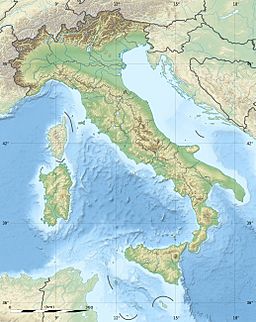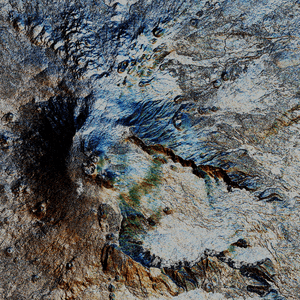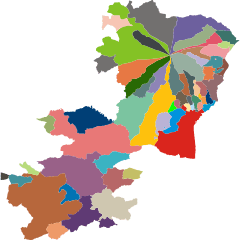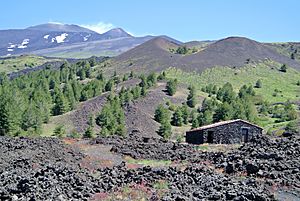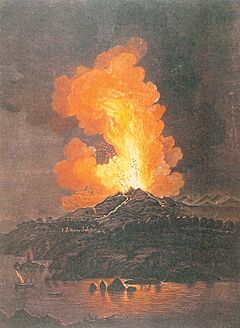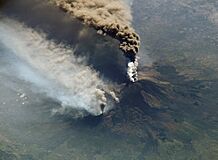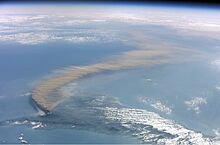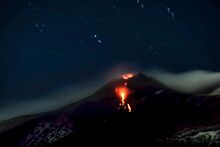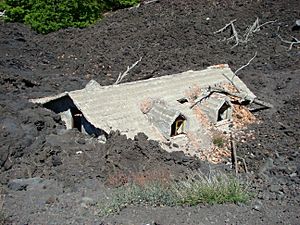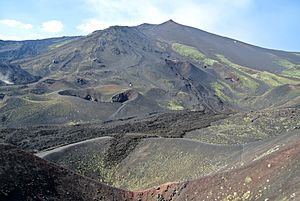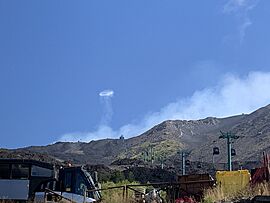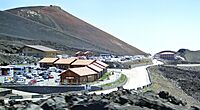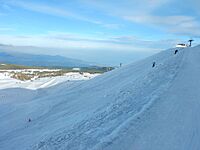Mount Etna facts for kids
Quick facts for kids Mount Etna |
|
|---|---|
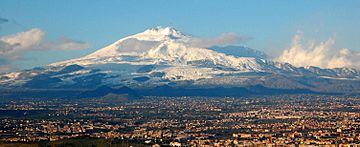
Etna with the city of Catania in the foreground (December 2007)
|
|
| Highest point | |
| Elevation | 3,403 m (11,165 ft) (varies) |
| Prominence | 3,403 m (11,165 ft) Ranked 54th |
| Listing | Ultra |
| Geography | |
| Geology | |
| Age of rock | 350,000–500,000 years |
| Mountain type | Composite volcano |
| Last eruption | 2 June 2025 |
| UNESCO World Heritage Site | |
| Criteria | Natural: viii |
| Inscription | 2013 (37th Session) |
| Area | 19,237 ha |
| Buffer zone | 26,220 ha |
Mount Etna, or simply Etna, is a very active volcano on the east coast of Sicily, Italy. It stands in the Metropolitan City of Catania, between the cities of Messina and Catania. Etna is one of the tallest active volcanoes in Europe. It is also the highest peak in Italy south of the Alps. Its height changes with eruptions, but it was about 3,403 meters (11,165 feet) tall in September 2024.
Etna covers a large area of about 1,190 square kilometers (459 square miles). This makes it the biggest active volcano in Italy. It is about two and a half times taller than Mount Vesuvius. Only Mount Teide in the Canary Islands is taller in the European-North African region.
Ancient Greek mythology tells us that the giant monster Typhon was trapped under Etna by Zeus, the king of the gods. They also believed that Hephaestus, the god of blacksmithing, had his workshop inside the mountain.
Mount Etna is one of the world's busiest volcanoes. It is almost always active. The rich soil from its volcanic ash is great for farming. Many vineyards and orchards grow on its lower slopes. Because it is so active and many people live nearby, the United Nations has named Etna a Decade Volcano. In June 2013, UNESCO added it to the list of World Heritage Sites.
Contents
Discover Mount Etna: Europe's Active Giant
Etna's Name and Ancient Stories
The word Etna might come from the Greek word "aíthō," meaning "I burn." Another idea is that it comes from an ancient Phoenician word meaning "furnace" or "chimney." In ancient Latin, it was called Aetna. In Arabic, people called it "Jabal al-Nār," which means 'the Mountain of Fire'.
Both Roman and Greek myths tell us that Vulcan (or Hephaestus), the god of blacksmithing, had his workshop deep inside Mount Etna. The volcano is also known as Muncibbeḍḍu in Sicilian and Mongibello in Italian. These names likely combine words for 'mountain' from different languages. Today, the name Mongibello refers to the area with Etna's main craters.
Etna's Fiery Past: Eruptions Through Time
How Etna Was Born: A Look at its Geology
Volcanic activity at Etna began about 500,000 years ago. The first eruptions happened under the sea near Sicily's old coastline. Around 300,000 years ago, the eruptions moved southwest. Then, about 170,000 years ago, activity shifted to where the main peak is today.
These early eruptions built up the first big volcano. It grew from alternating explosive blasts and slow lava flows. Sometimes, huge eruptions caused the top of the mountain to collapse. This formed large bowl-shaped hollows called calderas.
Between 35,000 and 15,000 years ago, Etna had very powerful eruptions. These sent out fast-moving clouds of hot gas and ash. Ash from these eruptions traveled as far as 800 kilometers (500 miles) north, reaching areas south of Rome.
Thousands of years ago, the eastern side of Etna collapsed. This created a massive landslide and a huge depression called 'Valle del Bove' (Valley of the Ox). Scientists think this happened about 8,000 years ago. It caused a giant tsunami that affected many parts of the eastern Mediterranean Sea. The steep walls of this valley show us a lot about Etna's past eruptions.
The most recent collapse at Etna's summit happened about 2,000 years ago. It formed the Piano Caldera. Later lava flows have mostly filled this caldera. However, you can still see it as a clear change in the mountain's slope.
Mount Etna is slowly sliding towards the Mediterranean Sea. It moves about 14 millimeters (0.55 inches) each year.
Famous Eruptions: Stories from History
Etna has erupted many times throughout history. The first known record of an eruption comes from Diodorus Siculus, an ancient historian.
In 396 BCE, an eruption of Etna helped stop the Carthaginians. They were trying to attack the city of Syracuse during a war.
A very strong eruption happened in 122 BCE. It caused a lot of ash and rock to fall on the city of Catania. Many roofs collapsed there. To help the people rebuild, the Roman government let Catania skip paying taxes for ten years.
The Roman poet Virgil wrote a description of an eruption in his famous poem, the Aeneid. He likely saw it himself.
The 1669 eruption was one of Etna's most destructive. It began on March 11, 1669. Lava flows destroyed at least 10 villages on the mountain's southern side. Five weeks later, on April 15, the lava reached the city walls of Catania. The walls mostly sent the lava into the sea, filling Catania's harbor. Some lava broke through a weak part of the walls, destroying a few buildings before stopping. Old records from that time do not mention many deaths from the lava. It is thought that later stories might have confused this eruption with a big earthquake that hit Sicily in 1693. Only 77 deaths have been clearly linked to Etna's eruptions throughout history. Two tourists were killed by a sudden explosion near the summit in 1987.
Since 1750, Etna has had seven eruptions that lasted more than five years. This is more than almost any other volcano.
Etna Today: Recent Activity
Etna is known as "Europe's most active volcano." Eruptions happen often. For example, there were 16 eruptions in 2001 alone. Several important eruptions have happened in the last century.
A major eruption took place in June 1923. In 1928, a large lava flow destroyed a town for the first time since 1669. The village of Mascali was almost completely covered by lava in just two days. The government at the time used the rebuilding efforts for propaganda. Mascali was rebuilt in a new spot.
-
Etna's 2002 eruption, photographed from the ISS
Other big eruptions in the 20th century happened in 1949, 1971, 1979, 1981, 1983, and 1991–1993. In 1971, lava buried the Etna Observatory and destroyed a cable car. In 1981, the town of Randazzo barely escaped fast-moving lava flows.
During the 1991–1993 eruption, the town of Zafferana Etnea was in danger. Engineers used explosives to redirect the lava flow. This saved the town, with only one building lost.
In July–August 2001, Etna had its first flank eruption since 1991–1993. This eruption was widely reported because it happened during the tourist season. It also occurred near a tourist area, making it easy to see. Parts of the "Etna Sud" tourist area were damaged.
A much larger eruption happened in 2002–2003. It sent a huge ash cloud high into the sky. This cloud was visible from space and ash fell as far away as Libya, 600 kilometers (370 miles) south. This eruption also damaged tourist stations. Footage from these eruptions was even used in the Star Wars: Episode III – Revenge of the Sith movie.
On September 4, 2007, a major lava fountain erupted from the Southeast Crater. It created an ash plume and a lava flow that traveled 4.5 kilometers (2.8 miles). Catania-Fontanarossa Airport closed for safety.
An eruption began on May 13, 2008, and lasted for 417 days. This was Etna's longest flank eruption since 1991–1993.
From January 2011 to February 2012, Etna's summit craters were very active. Frequent eruptions and ash clouds often forced the Catania airport to close. In July 2011, lava flows threatened the Sapienza Refuge, a main tourist spot, but were successfully diverted. In 2014, a new flank eruption started with lava flows and strombolian eruptions.
On December 3, 2015, an eruption from the Voragine crater sent a lava fountain 1 kilometer (3,300 feet) high. The ash plume reached 3 kilometers (9,800 feet) high. This activity continued, causing Catania airport to close for a few hours. Scientists use special equipment to measure gases from the volcano. This helps them predict eruptions.
On March 16, 2017, an eruption injured 10 people, including a news crew. Magma exploded when it touched snow.
On December 24, 2018, an eruption sent ash into the air. This closed the airspace around Etna. Two days later, a magnitude 4.9 earthquake shook nearby towns, damaging buildings and injuring four people.
Starting in February 2021, Mount Etna had a series of explosive eruptions. Volcanic ash and rock fell on nearby villages and cities, including Catania. The volcano erupted 11 times in three weeks in early 2021. These eruptions sent ash clouds over 10 kilometers (33,000 feet) into the air, closing Sicilian airports. No injuries were reported.
In February 2022, there were two eruptions. On February 11, lava fountains from the Southeast Crater reached almost 1,000 meters (3,300 feet) high. Ash blew west, and a large lava flow went down the western side. On February 19, another explosive eruption from the Southeast Crater sent lava flows towards the Bove Valley.
On May 29, 2022, a part of the Southeast Crater collapsed. A small lava flow emerged and headed towards the Leone Valley. This continued for three days.
Etna erupted again on July 4, 2024. This caused the Catania Airport to close due to ash. The airport reopened the next day.
On August 14, 2024, Mount Etna erupted strongly. It sent an ash cloud 9.5 kilometers (5.9 miles) into the atmosphere. Catania Airport had to close the next day.
On June 2, 2025, an eruption produced a pyroclastic flow. This fast-moving mix of hot gas and rock was likely caused by a collapse on the northern side of the Southeast Crater. Aviation authorities issued a red alert, estimating the volcanic cloud at 6.5 kilometers (4 miles) high.
Understanding Eruption Strength: The VEI
Scientists use the Volcanic Explosivity Index (VEI) to measure how powerful an eruption is. It's like a scale from 0 to 8. A higher number means a much bigger and more explosive eruption. Here's how Etna's eruptions have been rated since 1955:
| VEI | Number of eruptions (total=49) |
|---|---|
| VEI 0 |
1
|
| VEI 1 |
17
|
| VEI 2 |
24
|
| VEI 3 |
7
|
Mysterious Smoke Rings: Etna's Vortex Rings
Sometimes, Etna creates amazing smoke rings, called vortex rings. These are very rare to see from a volcano! Etna first erupted them in the 1970s, and then again in 2000. There's even video of the event from June 8, 2000. More rings appeared on April 11, 2013, and during the summers of 2023 and 2024.
Exploring Mount Etna: Fun Facts and Facilities
Where Etna's Borders Meet
The borders of ten different towns meet at the very top of Mount Etna. These towns are Adrano, Biancavilla, Belpasso, Bronte, Castiglione di Sicilia, Maletto, Nicolosi, Randazzo, Sant'Alfio, and Zafferana Etnea. This makes the summit a special spot where many areas connect.
Visiting Etna: Cable Cars and Ski Slopes
Etna is a major tourist spot in Sicily. Thousands of people visit it every year. A popular way to explore is by taking the road to the Sapienza Refuge ski area. This area is on the south side of the crater, at 1,910 meters (6,266 feet) high.
From the Refuge, a cableway takes you up to 2,500 meters (8,200 feet). From there, you can reach the crater area at 2,920 meters (9,580 feet).
The Ferrovia Circumetnea is a special narrow-gauge railway. It was built between 1889 and 1895. This railway goes around the volcano in a 110-kilometer (68-mile) semi-circle. It starts in Catania and ends in Riposto, north of Catania.
Etna also has two ski resorts. One is at the Sapienza Refuge, with a chairlift and three ski lifts. The other is smaller, on the north side, at Piano Provenzana near Linguaglossa. It has three lifts and a chairlift.
The Sapienza Refuge was the finish line for a stage of the Giro d'Italia bicycle race in 2011 and again in 2017.
Related pages
See also
 In Spanish: Etna para niños
In Spanish: Etna para niños
- Genista aetnensis, the Mount Etna broom
- List of Italian regions by highest point
- List of volcanoes in Italy
- Mount Vesuvius
- Sacred mountains
- Volcanic Seven Summits



